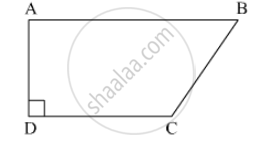Advertisements
Advertisements
प्रश्न
Prove that the points (a, b), (a1, b1) and (a −a1, b −b1) are collinear if ab1 = a1b.
उत्तर
The formula for the area ‘A’ encompassed by three points, `(x_1,y_1),(x_2,y_2),and (x_3,y_3)` is given by the formula,
`triangle=1/2[(x_1y_2+x_2y_3+x_3y_1)-(x_2y_1+x_3y_2+x_1y_3)]`
If three points are collinear the area encompassed by them is equal to 0.
The three given points are(a,b),(a-a1 b-b1)and(a-a1,b-b1) If they are collinear then the area enclosed by them should be 0.
`triangle =1/2[ab_1+a_1(b-b_1)+(a-a_1)b)-(a_1b+(a-a_)b_1+a(b-b_1))]`
`0=1/2[(ab_1+a_1b-a_1b_1+ab-a_1b)-(a_1b+ab1-a_-1b_1-ab-ab_1)]`
`0=1/2[ab_1+a_1b-a_1b_1+ab-a_1b-a_1b-a_1b+a_1b_1-ab+ab_1]`
`0=ab_1-a_1b`
`ab_1=a_1b`
Hence we have proved that for the given conditions to be satisfied we need to have
`a_1b=ab_1 `
APPEARS IN
संबंधित प्रश्न
For what value of x will the points (x, –1), (2, 1) and (4, 5) lie on a line ?
The class X students of a secondary school in Krishinagar have been allotted a rectangular plot of land for their gardening activity. Saplings of Gulmohar are planted on the boundary at a distance of 1 m from each other. There is a triangular grassy lawn in the plot as shown in the following figure. The students are to sow seeds of flowering plants on the remaining area of the plot.

(i) Taking A as origin, find the coordinates of the vertices of the triangle.
(ii) What will be the coordinates of the vertices of Δ PQR if C is the origin?
Also calculate the areas of the triangles in these cases. What do you observe?
Find the area of a triangle whose vertices are
(a, c + a), (a, c) and (−a, c − a)
The point A divides the join of P (−5, 1) and Q(3, 5) in the ratio k:1. Find the two values of k for which the area of ΔABC where B is (1, 5) and C(7, −2) is equal to 2 units.
For what value of k(k>0) is the area of the triangle with vertices (-2, 5), (k, -4) and (2k+1, 10) equal to 53 square units?
Find the value(s) of p for which the points (3p + 1, p), (p + 2, p – 5) and (p + 1, –p) are collinear ?
In ☐ABCD, l(AB) = 13 cm, l(DC) = 9 cm, l(AD) = 8 cm, find the area of ☐ABCD.

Using integration, find the area of the triangle whose vertices are (2, 3), (3, 5) and (4, 4).

In Figure 1, PS = 3 cm, QS = 4 cm, ∠PRQ = θ, ∠PSQ = 90°, PQ ⊥ RQ and RQ = 9 cm. Evaluate tan θ.
In a triangle ABC, if `|(1, 1, 1),(1 + sin"A", 1 + sin"B", 1 + sin"C"),(sin"A" + sin^2"A", sin"B" + sin^2"B", sin"C" + sin^2"C")|` = 0, then prove that ∆ABC is an isoceles triangle.
